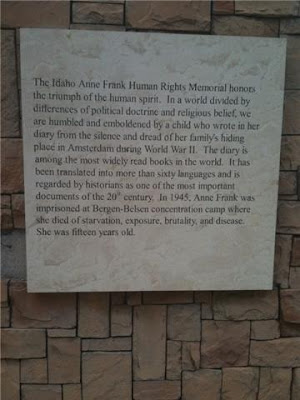
Friday, May 7, 2010
ART 108 SPRING 2010
MY FAVORITE ARTIST



SOAP/SPAM CARVING CONTEST
INSTALLATION PROPOSAL
ANNE FRANK HUMAN RIGHTS MEMORIAL



Saturday, May 1, 2010
ON THE RIGHTS OF MOLOTOV MAN
In the article “On the Rights of Molotov Man” I found myself having a very strong reaction and opinion in favor of the artist Joy Garnett. Starting with the Question posed, “does the author of a documentary photograph- a document who’s mission is, in part, to provide the public with a record of events of social and historical value- have the right to control the content of this document for all time?” I would like to answer that question with a question of my own. What art would we be without today if the art community only allowed “original” works having absolutely no resemblance or similarities to anything else in the world? Every artist, every writer every person who creates reflects their inspirations in their own works. For example the most obvious example of this would be Andy Warhol. His soup cans and Marilyn Monroe images are classic examples of and artist using someone else’s image as total inspiration for his own work.
While I wanted to sympathize with Susan Meiselas’ feeling as an artist, I personally could not get on board. While the idea of decontextualization of content is a valid concern, I don’t agree with the stifling of art or personal expression and I cannot believe the militant in the photograph would oppose the publicity of his cause. I think the Molotov Man probably appreciates the fact that the issues he felt and feels so passionately about has remained present in current works even thought is battle was being fought so many years ago.
"LIKE A MUSEUM"
CHRISTIAN BOLTANSKI
Boltanski was born in Paris to a Jewish father of Ukrainian heritage and a Corsican mother. He lives and works in Malakoff and is married to the artist Annette Messager, with whom he sometimes collaborates.
His artistic work is haunted by the problems of death, memory and loss; he often seeks to memorialize the anonymous and those who have disappeared.
In his preliminary years, Boltanski's paintings were concerned primarily with themes of historical significance. However, by the 1970s, Boltanski removed himself from the painting arena and began his quest for remnants of his own past through selected artworks. These artworks led Boltanski to question the substance he had used when creating his own artworks. However, this introspectivism supplied him with the motive for other artworks in which non-truths and the realisation of fundamental truths converged. Boltanski reconstructed his own youth in this method. In doing so, Boltanski used a vast spectrum of media. For example, film, performance, photography and video. It is interesting to note that Boltanski maintained this vision and direction without focusing on the obvious contradiction of his self-understanding as a painter.
Moreover, the combination of varied media is a fundamental part of the spatial dimension which has been the focus of Boltanski's work since the mid-1980s.
Quotations
I began to work as an artist when I began to be an adult, when I understood that my childhood was finished, and was dead. I think we all have somebody who is dead inside of us. A dead child. I remember the Little Christian that is dead inside me.
—Christian Boltanski, Tate Magazine Issue 2
I stopped going to school at about age 12, and I was very crazy, and I stayed at home. One day I made a little object in plasticine and my parents said it was good. So I started to make more, and to make drawings, and I began to make large paintings in my bedroom.—Christian Boltanski, Tate Magazine Issue 2
We are all so complicated, and then we die. We are a subject one day, with our vanities, our loves, our worries, and then one day, abruptly, we become nothing but an object, an absolutely disgusting pile of shit. We pass very quickly from one stage to the next. It's very bizarre. It will happen to all of us, and fairly soon too. We become an object you can handle like a stone, but a stone that was someone.—Christian Boltanski



ANNETTE MESSAGER
Annette Messager is a French artist who was born in 1943. She is known mainly for her installation work which often incorporates photographs, prints and drawings, and various materials.[1] Messager has exhibited and published her work extensively. She is the partner of artist Christian Boltanski.
Messager attended the École des Arts Décoratifs in Paris, France but was eventually asked to leave because she spent her time at museums and movie theaters instead of going to school.[2]
In 2005 her work was featured in the French Pavilion of the Venice Biennale, where she won the Golden Lion for her Pinocchio-inspired installation that transformed the French pavilion into a casino. some of her most famous work is her exhibition the messengers, which showcases a bunch of dead birds in sweaters which she knit herself, some of the birds heads were replaced by stuffed animal heads[3] She had a solo exhibition at the Centre Georges Pompidou in 2007.
(information found at http://en.wikipedia.org/wiki/Annette_Messager)



ANN HAMILTON:









